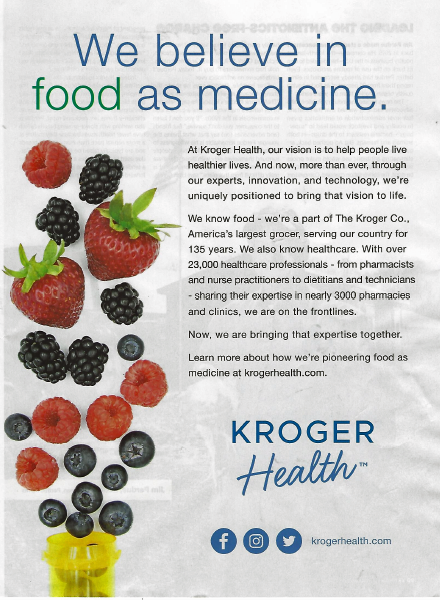
In reading the July/August issue of Eating Well magazine this week, I came across this ad which I scanned for you to see yourself: “We believe in food as medicine.” Signed, Kroger Health.
Here’s the introductory text in the full-page ad: “As Kroger Health, our vision is to help people live healthier lives. And now, more than ever, through our experts, innovation, and technology, we’re uniquely positioned to bring that vision to life,” the copy read.
“We know food,” the text continued, as part of The Kroger Co. which is the largest grocery chain in the U.S. celebrating 135 years in business. Kroger also employees 23,000 health care professionals employed in about 3,000 pharmacies in the chain.
In fact, Kroger Health is the umbrella under which all of the food chain’s health and wellness assets fit:
Kroger struck a deal with GoodRx in December 2018 to expand its prescription drug discount program. The grocer launched the OptUP app to support shoppers in personal nutrition and food style preferences. And, the food chain’s retail provider, The Little Clinic, gained Joint Commission accreditation last July.
Frequent Health Populi readers know this kind of ad would reel me in: I devoted many pages in my book, HealthConsuming: From Health Consumer to Health Citizen, in the chapter on “The New Retail Health,” and wax lyrically about Kroger in many ways such as allying with Walgreens on fresh food in a small footprint (retail pharmacy); the Wellness Your Way platform bundled with The Little Clinic, Kroger’s urgent care offering; and, Kroger’s alliances with health care systems and hospitals.
This ad inspired a call-to-action by the time I got to the last sentence pointing me to the Krogerhealth.com website, which I immediately visited. The landing page features a video with the following phrase overlaid: “Kroger Health. America’s trusted destination for health, wellness and nutrition.”
The video is a virtual tour of a Kroger grocery store featuring a dozen of the company’s 23,000 healthcare employees: a pharmacist, a pharmacy tech, a nutritionist, a nurse practitioner, and even a produce representative advising a shopper on the health benefits of fruit.
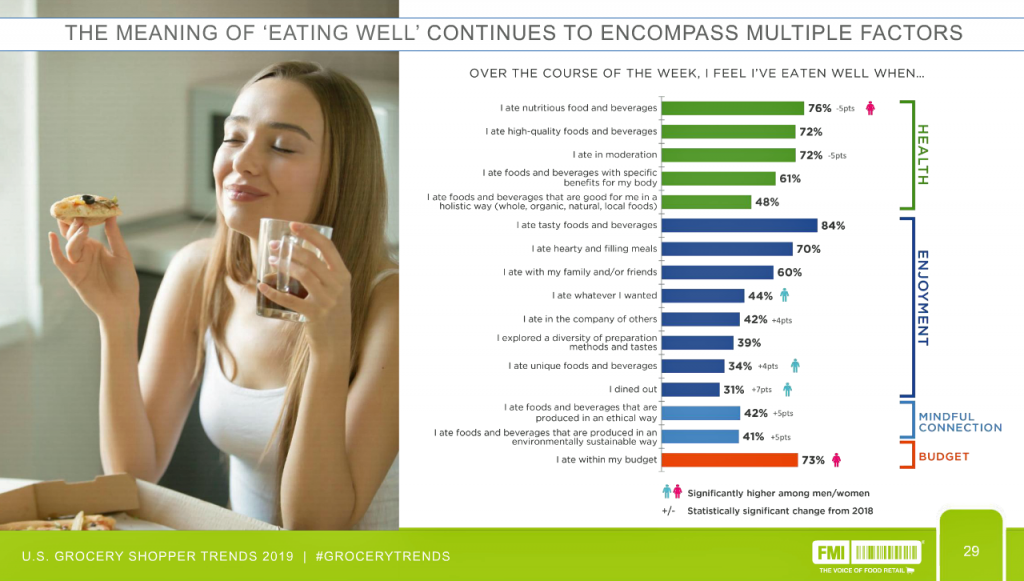 Kroger is taking a page right from the 2019 U.S. Grocery Shopper Trends Report from the Food Marketing Institute (FMI). I attended a session today during which experts from FMI and The Hartman Group analyzed the results of the report. (Here’s my most recent take of this annual report).
Kroger is taking a page right from the 2019 U.S. Grocery Shopper Trends Report from the Food Marketing Institute (FMI). I attended a session today during which experts from FMI and The Hartman Group analyzed the results of the report. (Here’s my most recent take of this annual report).
The first bar chart illustrates “the meaning of eating well” based on FMI’s consumer survey of U.S. adults. Note that the findings on how people know they are eating well fall into four categories: health, enjoyment, mindfulness, and their budget.
Health factors address nutritious food and beverages, closely followed by quality of food and eating in moderation. Health benefits are sought by 6 in 10 people.
Taste rises above all factors, agreed by 84% of U.S. consumers. Enjoyment involves taste, then the sense of feeling full and satiated, and in third place, sociability — eating with family and/or friends.
Mindfulness covers ethics and sustainability, important for 4 in 10 consumers.
And finally, eating within one’s budget is important to 7 in 10 people — roughly the same as the top factors of nutrition, quality, moderation, and feeling full.
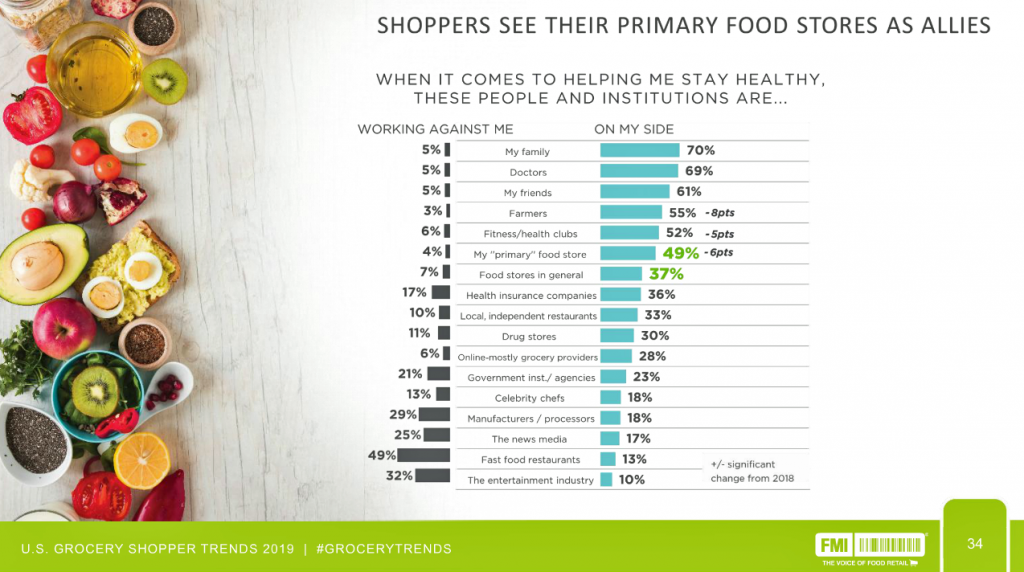
This second bar chart is also very important for the evolving health care consumer seeking food-as-medicine and using retail health channels. This question asked people what organizations and people help them stay healthy and are “on my side” to help me make health. These are the aqua blue bars on the right side of the graph.
Tied in first place are my family and doctors (in general — not “my doctor,” per se). These two personae, valued by 7 in 10 consumers, are followed by my friends, farmers, fitness/health clubs, and my primary food store (that is, the grocery channel the consumer most frequents during the week).
Now cast your eyes to the left — the grey/black bars. These are the folks we believe are working against our health. At the bottom are fast food restaurants (49% agreeing), the entertainment industry (among 32%), food processors and manufacturers (for 29% of people), and the news media (for 25% of people).
Intriguingly, government agencies tie at one in five people for both being on my side and working against me. Yet in a previous data point, one-half of Americans say that the USDA and FDA are responsible for nutrition. So while this is a mainstream opinion, this chart illustrates that most Americans don’t believe the government is pulling its weight for supporting nutrition for the nation.
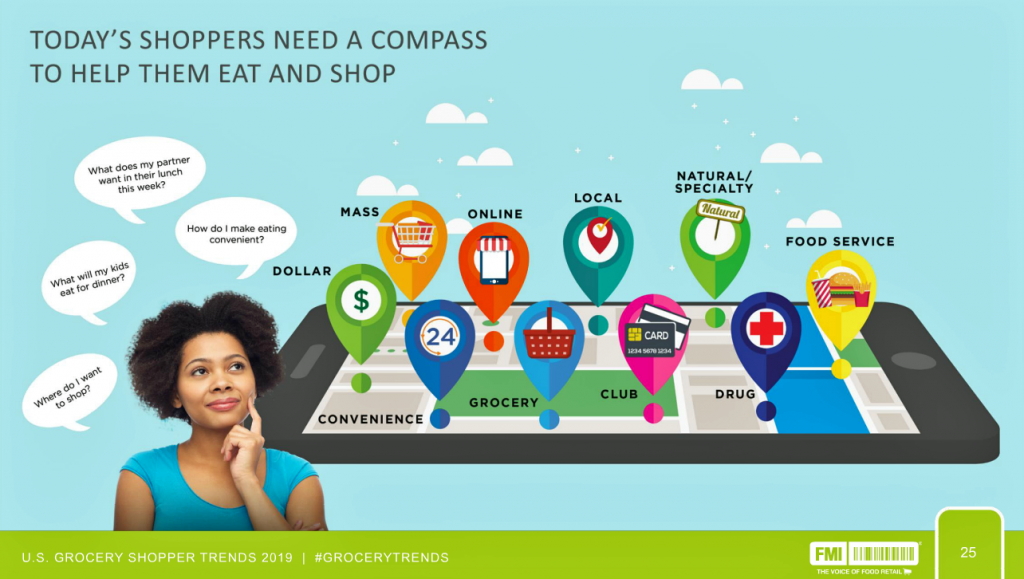 Health Populi’s Hot Points: Americans are tying eating well to shopping well — where the food-as-medicine relates to overall financial wellness, too.
Health Populi’s Hot Points: Americans are tying eating well to shopping well — where the food-as-medicine relates to overall financial wellness, too.
Grocery shopping is fragmenting beyond the traditional grocery store: people are going to small format stores, “C-stores” (convenience stores, also covered in my book in their search of reducing dependence selling “cokes and smokes” to healthier fare and living products), natural specialty stores, Big Box and club stores and of course, online via ecommerce.
Amazon has made inroads in its Pantry and food group, and has offered discounted Prime membership to people enrolled in Medicaid or SNAP (State food benefit) programs. This has the power to bring fresh and healthy food items to people living in food deserts — if people deem the discounted price for being in Prime is of value to them.
As we consider the role of social determinants and long-term social supports extended by insurance plans, e-commerce food delivery and subscription meal kits could be useful “prescriptions” for people who live with food insecurity and chronic conditions.
Note that drug stores are also on FMI’s map here where, “shoppers need a compass to help them eat and shop.”
Patients as payors and consumers want to live their lives based on their personal values — but they also seek value (for money) and support in helping choose healthier fare. This is a big opportunity for these community touchpoints to collaborate with health care providers, health plans, and fitness places (like the Y) to help people make health in ways that are engaging, impactful, value-priced and, the top-line for mainstream people — tasty.


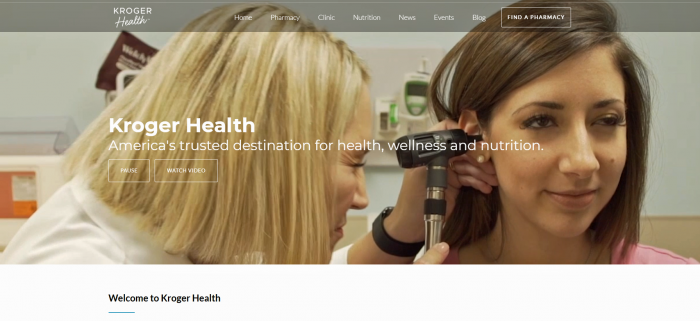


 Thanks to Feedspot for naming this blog, Health Populi, as a
Thanks to Feedspot for naming this blog, Health Populi, as a